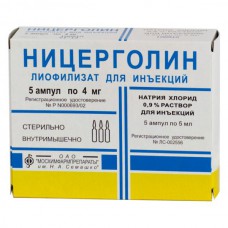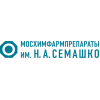Expiration date: 02/2026
Structure and Composition:
llyophilisate for drug of a solution for intramuscular injection. 1 ampoule contains: 4 mg nicergoline
Excipients: tartaric acid - 1.04 mg of lactose monohydrate (milk sugar) - 30 mg
4 mg in ampoules made of neutral glass ampoules 5 in blisters of PVC film.
5 ml of solvent - Sodium chloride 0.9% for injection in ampoules made of neutral glass ampoules 5 in blisters of PVC film.
One contour cell package with the drug and one contour cell package with a solvent with lancet ampoule or ampoule ceramic abrasive and instructions for use are placed in a pile of cardboard.
When using vials with a point or ring fracture scarifier not invest.
Description pharmaceutical form:
The porous mass or powder white and odorless.
Pharmacokinetics:
Major metabolites nicergoline: 1,6-dimethyl-8 & beta-hydroxymethyl-10 & alpha-metoksiergolin (MMDL, hydrolysis product) and 6-methyl-8 & beta-hydroxymethyl-10 & alpha-metoksiergolin (MDL, dimethylation product under the action of CYP2D6). Nicergoline active (> 90%) binds to plasma proteins, and its degree of affinity for the alpha 1-acid glycoprotein more than serum albumin. It is shown that nicergoline and its metabolites are distributed in blood cells. Pharmacokinetics of nicergoline is linear and does not vary depending on the age of the patient. Nicergoline is displayed in the form of metabolites, mainly by the kidneys (approximately 80% of the total dose) in a small amount (10-20%) - via the intestine. In patients with severe renal failure showed a significant reduction in the degree of removal of metabolic products in the urine as compared to patients with normal renal function.
Description of the pharmacological actions:
Nicergoline - ergoline derivative - improves metabolic and hemodynamic processes in the brain, reduces platelet aggregation and improves hemorheological parameters of blood, increases the rate of blood flow in the upper and lower limbs, showing alpha1-adrenoceptor blocking action. In patients with hypertension can cause a gradual moderate pressure.
Indications:
- acute and chronic cerebral metabolic and vascular disorders (due to atherosclerosis, hypertension, thrombosis or cerebral embolism, including transient ischemic attack, vascular dementia, and headache caused by vasospasm)
- acute and chronic peripheral metabolic and vascular disorders (organic and functional limb arteriopathy, Raynaud's disease syndrome caused by a violation of peripheral blood flow)
- as an adjunct in the treatment of hypertensive crises.
Contraindications:
- increased sensitivity to nicergoline or other ingredients
- recent myocardial infarction
- bleeding
- bradycardia
- orthostatic hypotension
- galactose intolerance
- lactose deficiency or glucose-galactose malabsorption
- pregnancy
- breast-feeding
- Children up to age 18 years (due to lack of data).
Be wary - hyperuricemia and gout history in combination with drugs that disrupt metabolism or excretion of uric acid.
Side effect:
The marked decrease in blood pressure, dizziness, diarrhea disorders (nausea, diarrhea, abdominal pain), feeling of fever, allergic reactions, sleepiness or insomnia. May increase the concentration of uric acid in the blood, and this effect is independent of dose and duration of therapy.
Drug Interactions:
It enhances the effect of antihypertensive drugs. Nicergoline is metabolized by the action of CYP2D6, so we can not exclude the possibility of interaction with drugs that are metabolized with the participation of the same enzyme.
Dosage and administration:
V / m, previously dissolved in the supplied sodium chloride 0.9%, 2 mg 2-4 times a day.
The dose, duration of therapy depends on the nature of the disease.
Patients with impaired renal function (serum creatinine & ge2 mg / dL) is recommended for lower therapeutic doses.
Overdose:
Symptoms: increased severity of side effects, except for the allergic reactions.
Treatment: symptomatic therapy.
Special instructions:
After introduction of nicergoline recommended patients be in a horizontal position for several minutes after injection, especially at the beginning of treatment, due to possible orthostatic hypotension.
Effects on ability to drive and use other mechanisms
Despite the fact that nicergoline improves reaction and concentration, its effect on the ability to drive and use sophisticated techniques not specifically studied. In any case, the period of treatment should refrain from driving motor vehicles and activities potentially hazardous activities that require high concentration and psychomotor speed reactions.
* The appearance of the package may vary


